Poodle Colors: Rare Colors and What they Mean
Among the many charming traits of Poodles, their wide range of colors makes them particularly striking and diverse pets. In this detailed analysis, we delve into the fascinating world of Poodle colors, exploring the genetics behind their diverse coat colors, as well as the common and rare shades you may encounter within the breed. Furthermore, we will address the intriguing process behind breeding for specific colors and the changes that can occur in a Poodle’s coat as they age, all while offering expert advice on grooming and care to maintain the beauty and health of their unique coats.
The Genetics of Poodle Colors
Poodle coat colors result from a complex interplay of genes that affect their pigmentation. Inherited from both parents, poodles can carry dominant or recessive genes that determine their coat color.
The primary gene that influences poodle coat color is the Melanocortin 1 Receptor (MC1R) gene. This gene decides the production of melanin, the pigment responsible for a dog’s coat color. Eumelanin and phaeomelanin are two types of melanin found in poodle coat colors, which contribute to black, chocolate, blue, and red, apricot and cream colors respectively. The interaction between various genes decides how much of each melanin type is produced that further determines the final coat color. A poodle with two dominant MC1R genes will have a black coat while one with two recessive MC1R genes will have either red or apricot coats.
Other sets of genes that influence poodle coat color are the dilution genes (D-locus) and brown coloration genes (B-locus). Dilution genes can lighten or dilute the poodle’s coat color, depending on the presence of other genes. The B-locus genes involve brown coloration and are responsible for determining if a poodle’s eumelanin will be black or brown. Moreover, the piebald gene, which can be dominant or recessive, creates parti-colored patterns on poodle coats.
The genetics of poodle colors are intricate and multifaceted, with many genes involved in determining the final coat color of these beautiful dogs. Genetic testing is a valuable tool that breeders often use to identify the presence and combination of these genes in their poodles, which helps them produce puppies with specific colors and patterns.
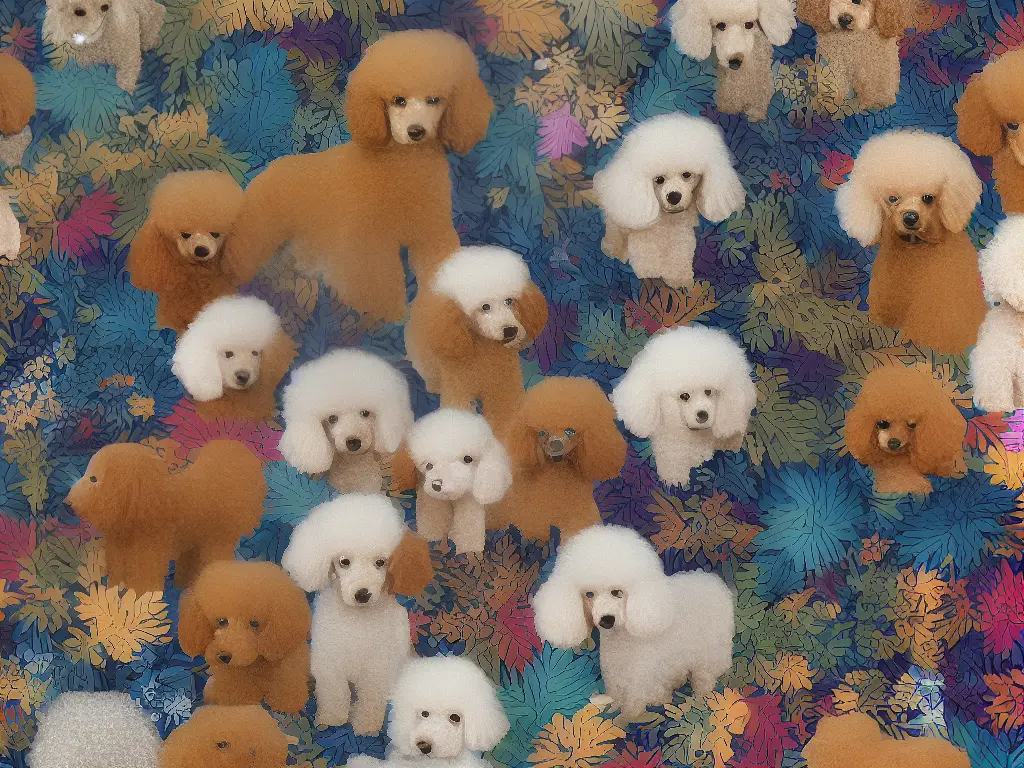
Common Poodle Colors
The vast array of poodle colors is truly remarkable, offering a unique variety of hues and shades for prospective dog owners to choose from. Among these colors, the most prevalent is black, which is characterized by a glossy, jet-black coat. Black poodles are striking in appearance, with their deep, dark coats providing a stunning contrast to their expressive eyes, and they typically experience less color fade as the years go by in comparison to their lighter-colored counterparts.
White Poodles possess a pure coat with an ivory or creamy hue, and it is often associated with elegance and sophistication. These Poodles require proper grooming to maintain their brilliant white appearance, which can easily become discolored from environmental factors or staining. Their enchanting dark eyes stand out against their light fur and contribute to their refined look.
Apricot Poodles are characterized by a range of warm tones, ranging from light peach to a deeper, richer orange. Their coat’s warm tone comes from the pheomelanin pigment in their coat, which also creates red and cream colors in Poodles. Interestingly, their coat’s color can change over time due to factors such as sunlight exposure and age.
Red Poodles have gained popularity due to their striking appearance, showcasing a deep, rich, and vibrant red coat reminiscent of a rusty or mahogany hue. The intensity of their color is primarily influenced by genetics and may require regular grooming to prevent fading. Red Poodles are often born with a darker coat, which lightens as they mature, ultimately revealing their bold and fiery red color.
Poodles are known for their unique coats and elegant appearance, and one of the fascinating aspects of this breed is the variety of colors they come in. These colors and patterns include silver, blue, cream, and even Parti Poodles, where colors are mixed on their coats.
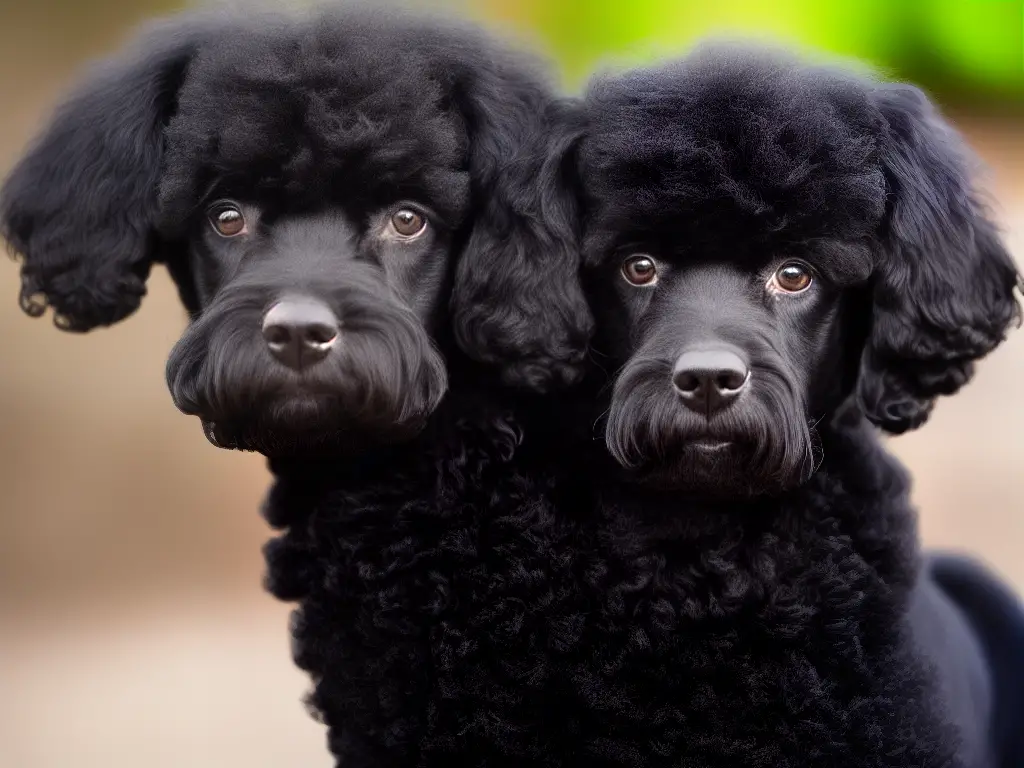
Rare Poodle Colors
These unique variations contribute to the Poodle’s distinctive allure and make them one of the most visually diverse dog breeds available. With such a wide range of colors to choose from, Poodles can appeal to a variety of personal tastes and preferences, making them an attractive pet choice based on their intelligence, temperament, and captivating physical appearance.
Silver: Silver is one of the more rare poodle colors and is strikingly beautiful. These poodles have a distinct appearance, with their coats appearing as a shiny silver-gray color. To be classified as silver, the poodle must have a fully silver coat by the time they turn two years old. This color is the result of a specific gene and can be seen in all three sizes of poodles – toy, miniature, and standard.
Cafe Au Lait: Another rare poodle color is cafe Au lait, which resembles the color of coffee with a generous amount of cream. These poodles have a soft, creamy brown coat that lightens with age, often developing a slightly silvery hue. Cafe Au lait poodles are less common than their chocolate counterparts and can also be found in all three poodle sizes. The specific gene responsible for this color is not yet clearly understood, but it is believed to be a variation of the brown gene.
Blue: Blue poodles may appear to be black, but their coats have a distinct blue or gray tint when viewed in sunlight. This color develops as the poodle matures, with the blue hue becoming more apparent as the dog ages. The unique color results from a dilution of the black gene, creating a softer, more muted appearance than a true black poodle. Like the other rare colors, blue poodles can be found in all three sizes.
Phantom: Phantom poodles exhibit two distinct colors in their coat, with a primary color and a secondary color appearing as markings. The most common combination seen in phantom poodles is black and tan, similar to a Doberman Pinscher or Rottweiler. The markings typically appear around the eyes, on the chest, legs, and under the tail. The specific genes responsible for the phantom coloring are still being researched, but it is believed to be a combination of specific color genes working together. Phantom poodles can also be found in all three sizes of the breed.
Rare poodle colors encompass far more than just silver, cafe au lait, blue, and phantom varieties. Poodles can also display unique colors and patterns such as apricot, brindle, and parti-colored coats. When considering a poodle with a rare color, it’s crucial to ensure the breeder involved is reputable and values the health and well-being of their dogs above all else. From the subtle elegance of silver poodles to the striking contrast of phantom poodles, these rare colors demonstrate the astounding beauty and diversity within the poodle breed.
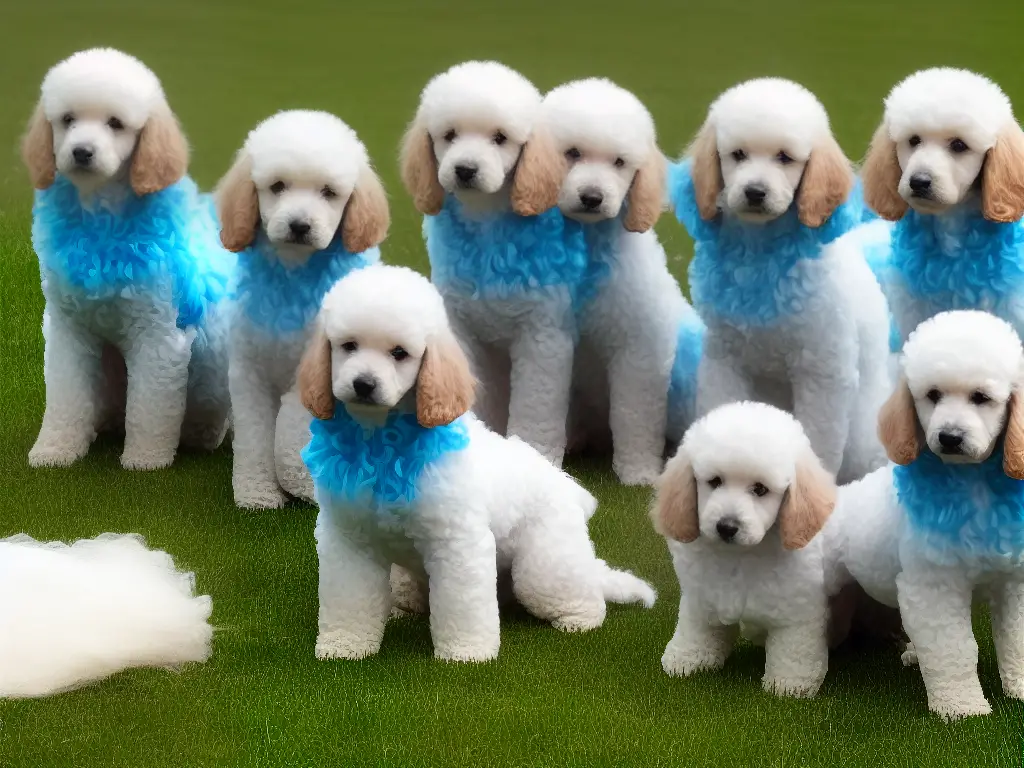
Breeding for Specific Colors
The process of breeding poodles for specific colors can be both fascinating and intricate, as a multitude of factors come into play when determining their final coat color. Breeders require an in-depth understanding of the genetic factors that influence coat color and pattern expressions, as well as the ways colors can be inherited and the potential combinations they might produce. Poodle coat colors can vary from solid shades like black, white, or red to more distinctive patterns and hues, including parti-colored, brindle, and phantom versions, further enhancing the breed’s striking appearance and general appeal.
To achieve the desired coat color in a poodle litter, breeders generally select and pair parent dogs exhibiting the sought-after color or trait. Since breeding for a specific color is driven by genetics, it is beneficial for breeders to thoroughly study the alleles, which are the differing forms of a particular gene, responsible for a specific coat color. For instance, when breeding for a black poodle, both parents should ideally possess the dominant black allele BB, ensuring a higher probability of their offspring inheriting the same allele, resulting in the desired black coat color.
However, breeding for particular colors becomes more complex than simply matching two dogs with the desired coat color together. This is because many coat color genes exist in pairs, which may be dominant or recessive, and the presence of one color gene can sometimes impact the expression of another. For example, a chocolate poodle requires two recessive genes (bb) for brown fur but if one of the parents carries a dominant black gene, the offspring might inherit the black color instead of the desired chocolate-colored coat. Moreover, the varying shades of colors like apricot, red, or silver can also arise due to the influence of additional, modifying genes.
In addition to understanding the basics of genetics and allele combinations, responsible breeders also prioritize the overall health and temperament of their breeding dogs. This ensures they remain dedicated to preserving and improving the breed as a whole, rather than just focusing on physical appearances. Genetic testing can provide valuable information on potential health issues related to coat color, such as skin sensitivities or risks associated with certain genetic mutations. For instance, merle poodles are known to have an increased risk of congenital deafness or eye abnormalities, further highlighting the importance of such ethical breeding practices.
An understanding of poodle genetics is essential for aspiring poodle breeders looking to achieve specific coat colors in their offspring. A solid foundation in the principles of genetics, knowledge of inheritance patterns, and recognition of the impacts of certain gene combinations on the overall health of the poodle are crucial. By maintaining a responsible and ethically-based breeding practice, breeders can work to reproduce certain coat colors in their poodle offspring without compromising the health and vitality of these beloved canines.
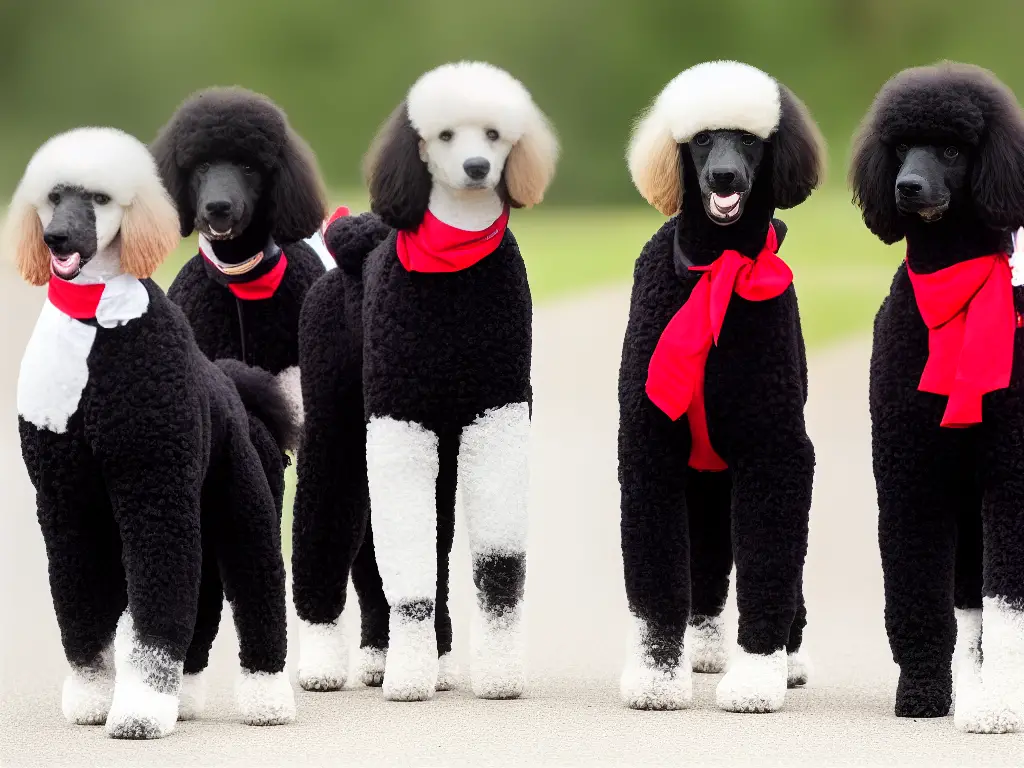
Color Changes over Time
Fascination around poodles often stems from the variety of coat colors they possess and the way these colors can change throughout a poodle’s lifespan. These captivating color alterations are primarily determined by the poodle’s genetic makeup, influenced by the combination of alleles inherited from their parents. Key processes that contribute to these color changes in poodles include silvering, fading, and clearance, showcasing the intriguing impact of genetics on these colorful canines.’
Silvering: is a process where a Poodle’s coat becomes progressively lighter over time. The silvering process typically starts when the dog is around 6 months old, and the progression continues through the first 2-3 years of their life. This results in a transition from their initial shade, which may be black or blue, to a silver or gray color. Dogs with the silvering gene will have a mixture of light and dark hairs, giving the coat a shimmery appearance.
Fading: also known as the ‘progressive graying’ gene, causes many Poodle colors to lighten as the dog ages. This occurs when the individual hairs lighten to various shades, depending on the genes and the original color. For example, a brown Poodle may fade to a lighter brown or a café-au-lait shade, while a black Poodle may gradually turn into a lighter blue or gray hue. Fading is more common in certain colors, such as apricot and red, and usually becomes apparent within the Poodle’s first two years.
Clearance: is another genetic-based process that affects Poodle coat colors. This term specifically refers to the fading of the base color in a multi-colored Poodle, such as a parti or phantom. The base color, often black, lightens to reveal the dog’s secondary color, like silver or white. This process is similar to silvering and fading, but it is distinct because it affects only one of the colors in the Poodle’s coat. Clearance can begin in puppyhood and continue as the Poodle matures.
From classic black to striking apricot, Poodles come in a variety of beautiful coat colors that can be influenced by their genetics and external factors. Environmental elements such as sun exposure, nutrition, and even hormonal changes can play a role in the coat color shifts a Poodle may experience as they age. Although changes are often subtle, they can contribute to variations in shade and highlights on their fur. Both for aesthetic reasons and to ensure proper care for their beloved pet, it’s essential for Poodle owners to be aware of the potential for coat color changes over time.
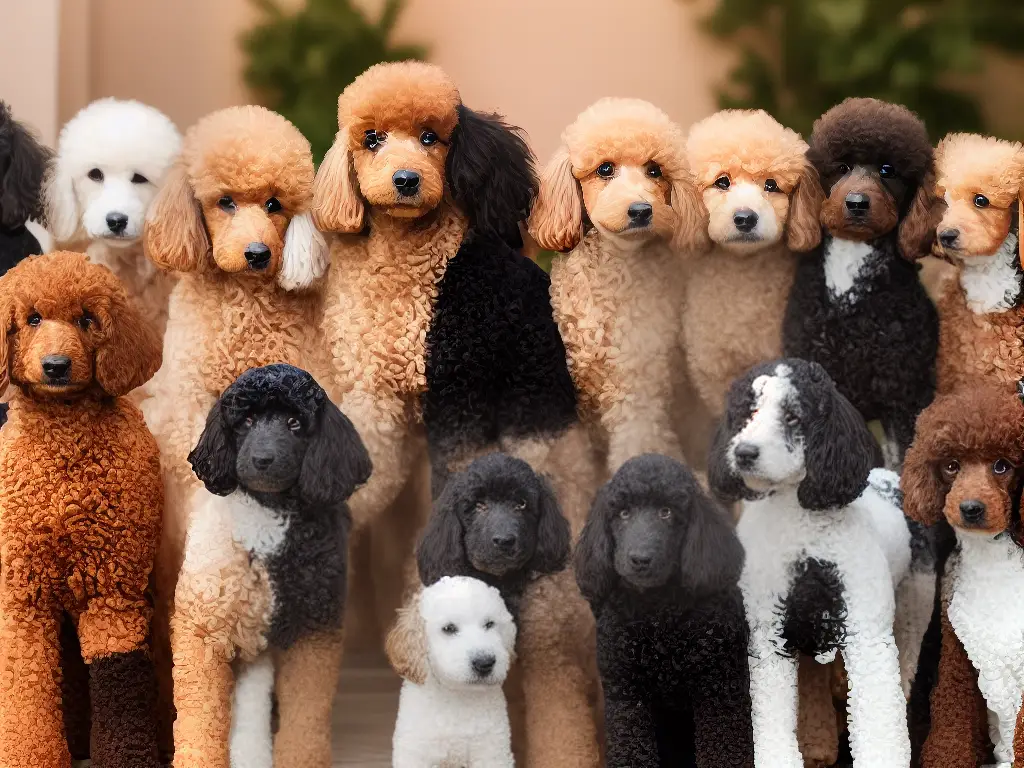
Grooming and Care for Poodle Colors
Given these varying poodle colors and their potential to change over time, proper grooming and care for their beautiful, curly coats is essential. Regardless of the shade – be it black, blue, silver, gray, cream, apricot, red, or white – Poodles have a unique hair texture that requires regular grooming to maintain both its health and appearance. By utilizing the right techniques, tools, and products, owners can help keep their Poodle’s coat in tip-top condition and preserve their striking looks for years to come.
Firstly, it is important to brush and comb your Poodle’s coat regularly—a minimum of two or three times a week is recommended, depending on the thickness and length of their coat. Regular brushing helps prevent matting and tangles, which are particularly common in Poodles due to their dense and curly fur. Use a slicker brush, pin brush, or comb specifically designed for Poodle coats to effectively remove loose hair and debris. For dogs with more intricate and sculpted hairstyles, such as show cuts, having a professional groomer perform the brushing will ensure the style is maintained properly.
In addition to regular brushing, bathing your Poodle every three to six weeks is crucial in maintaining their coat’s health and appearance. For Poodle coat colors that are lighter, such as white or cream, you may want to consider using a dog shampoo formulated for these colors, as they can help remove stains and enhance the brightness of the coat. For all poodle colors, it is essential to use a high-quality, gentle shampoo and conditioner suitable for their unique coat. This will help keep their fur soft, shiny, and tangle-free.
Trimming and grooming your Poodle’s coat is another essential aspect of maintaining its health and beauty. For most poodle owners, taking their dogs to a professional groomer every six to eight weeks is the best approach, as this will ensure that they are cared for properly and maintain a visually appealing appearance. Poodle hair can be styled in various ways, from sporting a shorter ‘puppy cut’ to more elaborate show cuts. The type of cut depends on the owner’s preference, lifestyle, and the dog’s specific needs. A professional groomer will be knowledgeable about which styles work best for various dog colors and keep their coat healthy and manageable.
Another key grooming aspect for Poodles of all colors is regular nail trims and cleaning of their ears and teeth. This is important not just for maintaining a well-groomed appearance but also for their overall health. Long nails can result in discomfort or injury for your Poodle, while neglected ears and teeth can lead to infections and other health issues. Consult with your veterinarian or a professional groomer for expert advice on proper nail trimming and ear and teeth cleaning techniques. By adhering to a thorough and regular grooming routine, a Poodle’s coat, regardless of color, can remain healthy and stunning.
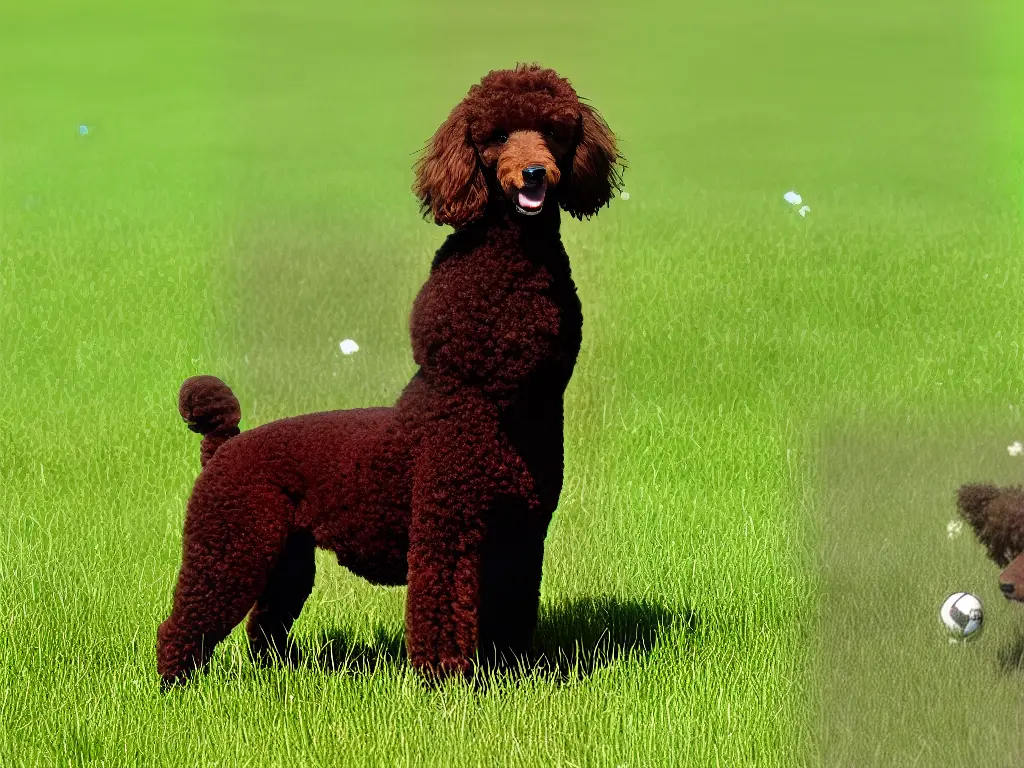
Unraveling the genetic complexities and marveling at the vibrant color spectrum of Poodles only adds to the allure of this intelligent and elegant breed. As we’ve discovered, their coat colors have much to do with the interplay of dominant and recessive genes, and breeders have mastered the art of selecting for particular shades. Moreover, understanding the processes of color change throughout a Poodle’s life can assist owners in better appreciating and caring for their beloved pets. Shared knowledge of proper grooming techniques and products ensures that these remarkable dogs will continue to captivate us with their stunning appearance for generations to come.
